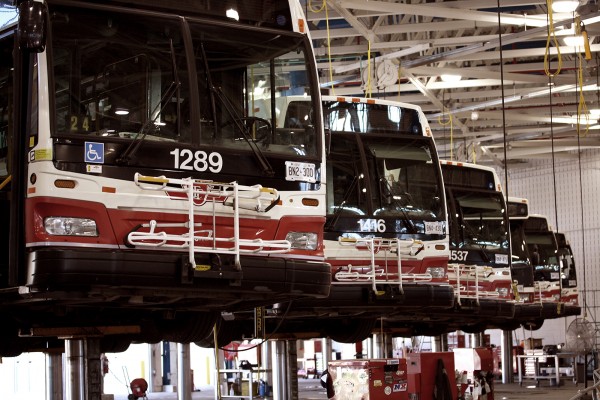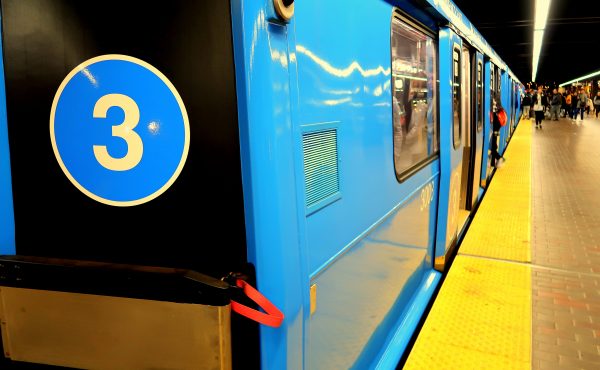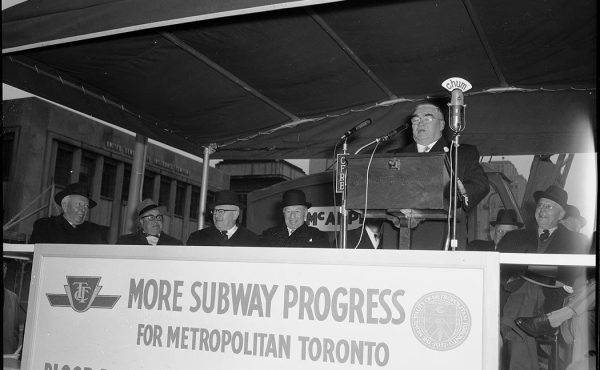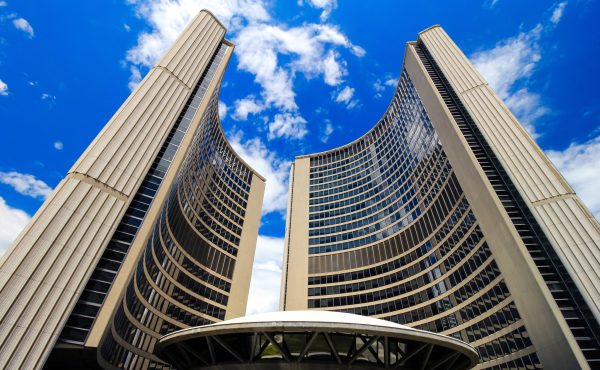Bad choices beget more bad choices.
If I lie on a government form, I will almost inevitably have to dissemble more in order to ensure the continued viability of the original lie. If I buy a luxury car on impulse without bothering to calculate how to cover the monthly payments, I will soon have to stop doing something that I need to do.
And that’s where we find ourselves with the $3.5 billion (but probably more) Scarborough subway. The bad decisions continue to pile up.
Consider the weekend’s news, unconvincingly denied by the mayor’s office, that there’s a plan afoot to sell Toronto Hydro and some parts of the Toronto Parking Authority portfolio, presumably to raise much needed capital to cover the costs of the things we can’t afford, like three-stop subways running through low-rise residential neighbourhoods.
Such sell-offs, though not yet approved, are the result of the specific sort of fiscal desperation that John Tory has brought down upon the city by pledging too many super expensive projects and then adamantly refusing to make tough choices.
At such moments, it’s always useful to bring the conversation back to opportunity cost: What is it that we won’t be able to do as a result of these choices? You don’t often see an “opportunity cost’ section on a staff report, but given the madness of council’s current transit plans, perhaps that kind of analysis — like the dissenting opinion of a Supreme Court justice — might prove useful.
Which brings me to the subject of buses, and specifically why we don’t talk more about the goal of making Toronto’s bus network into a service that is just so outstanding, and so easy to use, that local politicians compete with one another to promote major investments in this critical part of the TTC’s operations.
Or put another way, what would we get if we chose to put $3.5 billion into the TTC’s bus network instead of promoting white elephant schemes that will barely dent the transit access crisis that afflicts not just Scarborough but most of Toronto’s inner suburbs?
First, it’s important to note the political narrative of the bus file. Rob Ford persuaded council to make crippling cuts to suburban bus service. Olivia Chow opened her campaign for mayor by promising to reverse those cuts. Tory countered with Smart Track. But soon after winning, he scooped Chow’s pledge and restore service on 33 routes, at a cost of $95 million.
During this year’s budget process, the TTC has laid out a ten-year capital plan to allocate $2.4 billion to new or upgraded buses, as well as new garages and other related infrastructure (the TTC’s overall capital budget, of $9.3 billion, includes a $2.8 billion gap). The proposed 2016 operating budget, in turn, proposes about $11 million for a handful of bus service enhancements (e.g., late night service, Sunday morning service, etc.) and “reliability initiatives” designed to improve service on a handful of high traffic suburban corridors. (The TTC has successfully boosted reliability on Dufferin, one of the most heavily-used trunk lines.)
Overall, TTC officials says, the service improvements financed with the restored $95 million have benefited 300 million individual rides. But those changes are still delivered within the constraints of the TTC’s utilitarian service standards and its target financial returns for routes. Case in point: during peak periods, the agency’s crowding standard allows for buses to operate with up to 40% of passengers standing. And while the TTC claims that its network operates within five minutes walk of most neighbourhoods, the service standard still allows for wait times of up to 30 minutes between buses (compared to a five-minute head time for subways).
Regardless of where one stands on the subway-LRT divide, there’s a broad and largely unchallenged consensus that rail is where we should be going. But we’ve never really had a broad conversation about what would happen if the city opted instead to invest comparably giant sums in the bus system.
Which, let’s face it, is an serious oversight, given the sheer reach of the network. According to the TTC, the agency operates 143 routes covering 7,000 km, with its 1,900-odd vehicles logging some 131 million km last year. Buses deliver more passenger trips each year than subways (245 million compared to 220 million), and they stop in 9,500 locations, compared to the 74 stations on the subway/RT network.
So what if we do some fantasy bus math as a counter-point to the magical thinking that passes for the planning for the $3.5 billion Scarborough project. If council doubled the current ten-year capital budget ask ($2.4 billion) for expansion and re-investment in the bus network, there would be enough left over (i.e., from the $3.5 billion committed by the three orders of government to the Scarborough subway) to build and equip LRT routes on Queen’s Quay East, Bremner Boulevard and the Portlands, according to TTC documents.
What’s the impact? The $2.4 billion in the 2016-2025 capital budget proposes 1,400 new buses, each with a lifespan of about 18 to 20 years. The TTC currently operates almost 1,900 buses, and about 1,500 are running at peak periods.
What happens — again, incomplete analysis here, shorn of the important accompanying discussion about operating costs — if the TTC expands its bus fleet by 75%? Do we create a service no longer characterized by strap-hanging and mosh-pit conditions? Does missing the bus become little more than a brief delay because the next one’s already in sight (think of the Spadina streetcar service)? Does the combination of sharply reduced head times and travel comfort attract more passengers? And how much will increased ridership offset higher operating costs associated with service expansion (i.e., more drivers and fuel)? On this last point, the TTC is already accumulating evidence that its bus service reliability investment generates new fare revenue.
Here’s another angle: there’s mounting evidence that new subway and LRT investment is linked to rising residential real estate prices. Because so many of the city’s poorest neighbourhoods are situated in the inner suburbs, will the new lines inadvertently drive up the cost of living in areas whose residents can scarcely afford to pay more for housing and mobility?
Or let’s think about waiting for that bus. Imagine if the TTC took the $1 billion left over after spending that $2.4 billion to expand the fleet and embarked on a plan to transform all those forlorn suburban bus shelters. Do the math: with 9,500 stops, the TTC could invest $100,000 per shelter and still have a few bucks left over. A TTC bus shelter currently costs about $25,000. In other words, it’s possible to envision turning the TTC’s entire portfolio of bus stops into comfortable places rather than tarted-up billboards.
Again, the point is that as council moves to layer one calamitous decision on top of another, we should work harder to game out what else the Scarborough subway spend would buy, and whether a dramatic investment in the bus fleet in particular would alter public attitudes about the most extensive part of the TTC’s operations.
The billions that will go towards those three stops could boost a form of transit service that already touches every neighbourhood in every corner of the city.
Buses, buses, buses. It’s high time we have that debate.






12 comments
One sure way to reduce bus wait times? Don’t place stops 200 m. apart from each other.
There should be a minimum of 1 km. between stops.
This would actually be a great idea to replace the current Scarborough LRT. Providing you supply enough designated vehicles you already have the existing transit only lanes, which could be converted for wheels as opposed to rail, and you have the stations which those buses could drive straight into. Ensure that all the buses on this route are electric and VOILA! A perfect, cost-effective solution with money to spare
Written like someone who doesn’t have to use the bus portion of the TTC. I do. I live in the inner suburbs and thus spend way too much time on TTC buses. Buses suck! They are noisy, they belch fumes, they make you nauseous with their jerkiness, they are subject to the lead-foot subjectivity of bus drivers. I DREAD the first and last 20 minutes of my TTC commute. And I only have to submit to it for 20 minutes. I can not imagine the poor riders coming in from farther out and having to endure that ride. As a monthly metropass holder (aka someone who uses the system a lot and is therefore qualified to give an opinion) rail is ABSOLUTELY the way to go. Your article is so off, I couldn’t even finish reading it.
Veronica —
Spoken like someone who doesn’t see the cost of building rail everywhere (and if you didn’t finish reading the whole article than don’t comment).
Veronica, this is precisely my point. The service is poor specifically because we under-invest, and we under-invest because other, far more costly projects with noisy political patrons tend to get the big dollars. I’m saying, what if we turned the tables?
Rail separate from autos is definitely the way to go – smoother, faster service than buses. Yes it costs a lot more, so strategic decisions need to be made on which streets and routes for rail.
Buses everywhere just begets what LA had before it invested billions in a rail network (subway, LRT, and commuter rail).
I take buses, streetcars, subway & GO train. Buses have their place. Exclusive bus lanes are great for speeding them up, but they need enforcement, which the politicians and Police aren’t will to do.
Most importantly, we need to get autos off the streetcar lanes in the city. We could have much more capacity moved down our streets (80+ per streetcar vs 1.3 per car average – pretty simple math politicians!) by keeping car storage off our main streets and autos off the streetcar lanes.
With political will this can happen. Dozens of European cities have done it – the city won’t crash.
Converting the SRT to a busway would definitely have benefits. Rather than a forced transfer, buses could continue along the route into Kennedy station. It could also act as a conduit for regional buses (YRT/Viva, GO, DRT/DART) to connect to the subway in the east end.
From a fiscally conservative bang for the buck perspective, shifting money from overbuilt projects like the Scarborough subway into bus expenditures etc would both improve the rides of more existing commuters and be much more likely to attract new riders.
Politicians backing lousy plans use all kinds of excuses to avoid comparisons to other options. Tory says Scarborough is a done deal so discussing it will only stall progress. As for SmartTrack he says its part of his election mandate, and critics are Douglas Downers. Besides he has reportedly not seen any estimates of SmartTrack west costs which differ from campaign estimates.
You can’t space bus stops 1km apart, that takes away the convenience of “local” bus service.
the TTC needs to expand express and rocket services to almost every major corridor in the city, with dedicated lanes like Eglinton.
Lawrence, Don Mills, Markham Road, Dufferin, Victoria Park…the list goes on…these routes need express bus service, allowing local bus service to be more accessible and comfortable to those who rely on the TTC locally and getting commuters across town quicker.
I want council to talk about buses. Rush hour without cars and dedicated buses every 10 minutes. Electric buses to reduce fumes. Move people with making them pay twice the fare for efficient service. I am referring to the Avenue road express bus serving ththat community.
We need to talk not re-invent the wheel people.
Lula – yes I do see the cost of building more rail. As a Toronto homeowner I am dismayed that property taxes aren’t being raised more to increase public transit expenditures.
John – investing in more buses is not going to make my ride less noisy, less polluting, less jerky and less prone to bus drivers who drive as if they are in the Indy 500, nor will it improve frequency since the schedule is already at every 10 minutes or less. If you prefer to invest in LRT rather than subway, fine, so long as the LRT is run European style i.e. trams have right of way over all other forms of transport and only have to stop when dropping off/picking up passengers. What has been implemented on Spadina and St. Clair is not efficient transit. But for gods sake, move away from buses, please!
I always was under the impression building rail (I guess specifically LRT) would remove the need for buses (or at least most buses) on the road. I always thought this would be one of the great benefits of the old Transit City plan – more light rail frees up more buses for use elsewhere. Imagine if, for example (as a route that draws constant criticism), Dufferin had light rail travelling up it – the buses freed up could help improve service elsewhere. Also creating the right road conditions to have them operate optimally would be great. In Brampton, there are queue jumping areas at intersections to allow buses to get ahead of traffic.